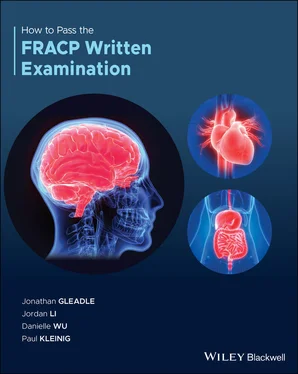The American College of Cardiology and the American Heart Association (ACC–AHA) have developed an algorithm for risk stratification in patients with HOCM who would benefit from primary prevention of sudden cardiac death with implantable cardioverter–defibrillators (ICDs). ICDs should be considered in young and middle‐aged patients whose clinical profiles include one or more major risk factors, include family history of HOCM‐related sudden death, unexplained syncope, multiple, repetitive non‐sustained VT, massive LVH (≥30 mm), left ventricle apical aneurysm, and extensive late gadolinium enhancement. If the level of risk remains uncertain, other clinical features such as left ventricular outflow obstruction, hypotensive response to exercise, can serve as mediating factors.
Management strategies for variable clinical manifestation of HOCM include ICDs to reduce the risk of sudden cardiac death, surgical myectomy (with alcohol septal ablation as a selective alternative) for permanent reversal of heart failure in patients with outflow obstruction, heart transplantation for patients with non‐obstructive end‐stage disease, and anticoagulant therapy to prevent embolic stroke caused by atrial fibrillation.

Maron B. Clinical Course and Management of Hypertrophic Cardiomyopathy. New England Journal of Medicine. 2018;379(7):655–668.
https://www.ncbi.nlm.nih.gov/pubmed/30110588
19. Answer: B
This patient has papilloedema with almost complete obliteration of the margins of the optic disc and several hypertensive haemorrhages. Changes in hypertensive retinopathy include: Focal arteriolar narrowing and arterial venous nicking, flame or blot haemorrhages, microaneurysm, hard exudates, cotton wool spots, and papilloedema.
The Keith‐Wagner grade is used to classify the severity of hypertensive retinopathy:
Grade 1: Isolated narrowing of the arterioles.
Grade 2: There is moderate to marked narrowing of retinal arterioles associated with a copper wire appearance or arteriovenous nicking.
Grade 3: Hypertensive retinal haemorrhage or exudates are present.
Grade 4: Papilloedema is present.

Modi P, Arsiwalla T. Hypertensive Retinopathy [Internet]. Statpearls.com. 2020 [cited 16 November 2020]. Available from:
https://www.statpearls.com/articlelibrary/viewarticle/35600/
20. Answer: C
All of the above patients have a Class I indication for an ICD implantation except in the patient who just had a myocardial infarction two weeks ago. There is no survival benefit of early ICD implantation in patients with ischaemic cardiomyopathy. Evaluation of patients for ICD implantation should wait at least 40 days post‐myocardial infarction and an ICD is then indicated in patients with left ventricular ejection fraction less than or equal to 35% and at least 90 days post revascularisation, with NYHA class II/III symptoms despite guideline directed medical therapy.
The current indications for ICD to prevent sudden cardiac death (SCD) are summarised in Table 1in the following full text article based on the 2017 American Heart Association/American College of Cardiology/Heart Rhythm Society (AHA/ACC/HRS) guidelines for management of patients with ventricular arrhythmias and the 2015 European Society of Cardiology (ESC) guidelines for management of patients with ventricular arrhythmias.

Chieng D, Paul V, Denman R. Current Device Therapies for Sudden Cardiac Death Prevention – the ICD, Subcutaneous ICD and Wearable ICD. Heart, Lung and Circulation. 2019;28(1):65‐75.
https://www.heartlungcirc.org/article/S1443‐9506(18)31920‐6/fulltext
21. Answer: D
This patient has infrequent palpitations which happen around once every 6 months. Three‐ or seven‐day Holter monitoring may not capture arrythmias due to the infrequent events.
It is important to know the frequency of palpitations or syncopal events to decide what the best way is to investigate potential underlying arrhythmias.
The next preferred step of investigation for this patient is an implantable loop recorder due to the infrequent symptoms and the long duration between events.
It will be important to investigate underlying coronary artery disease in this patient with significant risk factors for cardiovascular disease due to his past medical history, which may contribute to his symptoms.
In patients with infrequent unexplained syncopal episodes, implantable loop recorders have high rates of diagnosing arrythmias compared to external loop recorders or physician follow‐up. Implantable loop recorders are pen drive sized device inserted under the skin under local anaesthetic and are capable of recording cardiac events for up to three years. Implantable loop recorders can be considered in patients with cryptogenic stroke to detect paroxysmal or infrequent atrial fibrillation if the initial in‐hospital or Holter monitoring are unable to detect atrial fibrillation, which is a risk factor for embolic stroke.
Wearable devices are gaining popularity in the recent years and may aid in detection of arrythmias such as atrial fibrillation and supraventricular tachycardia. However, in patients with syncopal episodes, they are unable to record these events due to potential loss of consciousness with syncope. More studies are required to see how to integrate smart devices to improve patient care.

Khalil C, Haddad F, Al Suwaidi J. Investigating palpitations: the role of Holter monitoring and loop recorders. BMJ. 2017; 358: j3123.
https://www.bmj.com/content/358/bmj.j3123.long
22. Answer: A
Evolocumab and alirocumab are monoclonal antibodies inhibiting Proprotein Convertase Sublitisin/Kexin Type‐9 (PCSK9). PCSK9 inhibits low‐density lipoproteins (LDL) receptor recycling, which in turn limits the ability for tissue to sequester LDL from the extracellular space. Individuals with activating mutations of the PCSK9 gene have high LDL and poor cardiac outcomes; conversely individuals with inactivating mutations of the PCSK9 gene have low LDL levels and relatively good cardiac outcomes. PCSK9 inhibitor therapy is administered by subcutaneous injection and is indicated where statin/combination therapy has failed to reach LDL targets. PCKS9 inhibitors have shown small but meaningful reductions in cardiovascular risk and mortality and have a greater protective effect for individuals with higher baseline LDL.
The primary action of statins (eg. rosuvastatin) is to decrease hepatocyte production of cholesterol by inhibition of HMG‐CoA (3‐hydroxy‐3‐methylglutaryl‐coenzyme A) reductase, thereby increasing LDL receptor synthesis, and increasing LDL clearance. Ezetimibe is an azetidinone cholesterol absorption inhibitor, which acts by blocking NPC1L1 (Niemann‐Pick C1‐Like 1) a key brush‐border transport protein. Mipomersen is an example of a newer advance in lipid‐lowering therapy, which inhibits synthesis of apoB‐100 and LDL, and can be considered for use in homozygous familial hypercholesterolaemia but hepatotoxicity is a significant potential adverse effect.
Читать дальше
















